

Development software - Iterative & Incremental development. IterativeDevelopment is often confused with IncrementalDevelopment. software - Iterative & Incremental development "Show me your flowchart and conceal your tables, and I shall continue to be mystified.

Show me your tables, and I won't usually need your flowchart; it'll be obvious". - Fred Brooks, The Mythical Man-Month. ----------------------------------------------------------------------------------------DEVELOPMENT PLANNING & PREREQUISITESCone of Uncertainty:All software projects are subject to inherent errors in early estimates.The Cone of Uncertainty represents the best-case reduction in estimation error and improvement in predictability over the course of a project.Skillful project leaders treat the cone as a fact of life and plan accordingly.0. Initial concept1. Approved product definition2. Software development is a process of continuous refinement.A well-run software project attacks areas of highest variability first to narrow the cone as rapidly as possible.
Agile 2 – THE NEXT ITERATION OF AGILE. History Of Iterative. History of Iterative and Incremental Development.
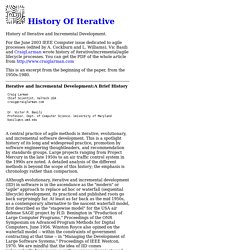
For the June 2003 IEEE Computer issue dedicated to agile processes (edited by A. A brief history of agile methods · Intense Minimalism. There is a common misconception that agile methods are just for smaller projects.
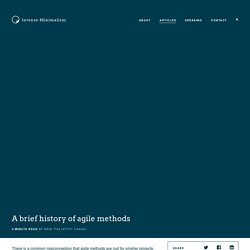
While it’s obvious the falsity of this statement to anyone that actually did it properly, it’s also obvious when we check the origins of agile. 1930s — Walter Shewhart proposes a series of short “plan-do-study-act” (PDSA) cycles.1950s — The X-15 hypersonic jet applied incremental and iterative development.1958 — Project Mercury (NASA) software development, ran with half-day iterations. “All of us, as far as I can remember, thought waterfalling of a huge project was rather stupid, or at least ignorant of the realities.” — Weinberg G. M. (Project Mercury) Agile Engineering Blog Posts - Cprime.
History of iterative larman and basili ieee computer. Mile High Agile 2019 - 37 Invited, Accepted and Proposed Submissions. Over the years as an Agile practitioner, I've seen mindsets change on Agile and what it should and shouldn't be used for.

The good news is that the 'shouldn't be used for' list continues to go down. Stories and Story Points. Agile and Jira. Download – Zen Ex Machina – The blog. 7 Product Manager / Product Owner Archetypes – John Cutler. The TameFlow Community. SafeScrum – Discussions and posts about SafeScrum and the application of agile practices in safety-critical software development in general. Practice Library.
What Is Agile? (10 Key Principles of Agile) Non-verbal Exercises for Agile Retrospectives - Ben Linders. Non-verbal exercises can be used in agile retrospectives to “hear” from introverts and involve people who find it difficult to speak up in groups.
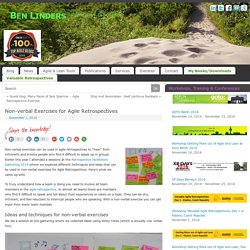
Earlier this year I attended a sessions at the Retrospective Facilitators Gathering 2016 where we explored different techniques and ideas that can be used in non-verbal exercises for Agile Retrospectives. Here’s what we came up with. To truly understand how a team is doing you need to involve all team members in the agile retrospective. Practical agile for enterprise IT. Scalable Agile Estimation and Normalization of Story Points: Introduction and Overview of the Blog Series (Part 1 of 5)The Agile Management Blog. Agile estimation topics such as relative size effort estimation in story points and velocity based on story points are well-known.

Relative size estimation done as a team effort leads to improved shared understanding of stories. It takes less time than estimating effort in time units (ideal hours or idea days). Relative size estimates in story points are more stable than estimates done in time units. Guiding Organizational Design With SOA Principles -LeadingAgile. A couple of years ago, Mike Cottmeyer wrote a blog post on How to Structure Your Agile Enterprise.
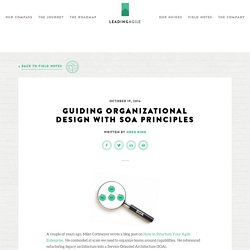
He contended at scale we need to organize teams around capabilities. He referenced refactoring legacy architecture into a Service Oriented Architecture (SOA). We have proven this with many of our clients over the last couple of years. We want to organize around products and their capabilities. A capability is an outcome-based view of what the product does. Agile Uprising.
Agile Sites. Agile Books. Agile Graphics - Agile Project Management TrainingAgile Project Management Training. Do you want to become an Agile trainer but don't have the time or expertise to create the materials?

You can license all of our courses and trainings. Click here for more information. These are some custom graphics I created for my Agile training courses. Feel free to download and re-use. Please keep the bit.ly:
Product Roadmap. Kanban. AgileSparks. Chp%253A10.1007%252F978 0 387 72804 9 16. Schedule Questions: Pair Programming and the PNR Curve. Converting effort estimates into project durations and team sizes is an important part of project planning.
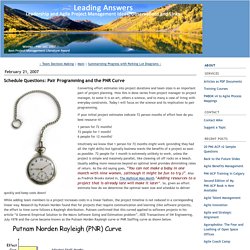
How this is done varies from project manager to project manager, to some it is an art, others a science, and to many a case of living with everyday constraints. Today I will focus on the science and its implication to pair programming. If your initial project estimates indicate 72 person months of effort how do you best resource it? 1 person for 72 months? 72 people for 1 month? Intuitively we know that 1 person for 72 months might work (providing they had all the right skills) but typically business wants the benefits of a project as soon as possible. 72 people for 1 month is extremely unlikely to work, unless the project is simple and massively parallel, like cleaning oil off rocks on a beach. While adding team members to a project increases costs in a linear fashion, the project timeline is not reduced in a corresponding linear way.
Tn = F * Effort ^ 0.33. LeadingAnswers: Leadership and Agile Project Management Blog. This article is less about agile techniques and more about the people related challenges of today’s agile projects.

As work switches from industrial work to knowledge work, companies face a perfect storm of employee engagement and retention issues. On the one hand the time taken to learn a job is increasing as domains become more complex and new tools add layers of abstraction and integration problems. On the other hand the average time spent in a job is decreasing. Frequent job changes are now the norm and long term workers are a rarity. Alleman EV Agile Success%20(V3) 14 Obstacles to Agile in Government. Why Scrum Doesn’t Work in the Enterprise. June 10, 2014 | Author: PM Hut | Filed under: SCRUM Why Scrum Doesn’t Work in the Enterprise By Curtis Guilbot Stop me if you’ve heard this one before: A couple of Fortune 50 clients I worked with had recently spent a few million on training their development staff in “enterprise scrum” with a well-known author/trainer in the field. There were posters everywhere, town hall meetings (which were expensive all-day affairs, since this was a global company), a gung-ho spirit among many department managers.
Guess what happened? #NoEstimates? Get a grip. Sprint level estimations are vital. The purist in me loves the concept of no estimates. Imagine a world where designers could just design until everything looked perfect, developers could just code until everything worked exactly the way they wanted and at the end of it all, whenever that might be, their labour of love is packaged and delivered to the happily waiting customer. Let’s all take a moment to get realistic. The whole elitist, self righteous attitude towards the entire #NoEstimates movement needs to stop. Would you take your car in for an MOT and tell the mechanic to do whatever work needs completing to meet your goal of passing the MOT without expecting an estimate?
Absolutely not. I’m afraid the same is true of software development. What we should be focusing on is not removing estimates from the process, but turning estimates into something that are actually useful. We need to be pragmatic. Lean Agile in Construction Projects - 9/11/11 - 10 Years Later. I spent 2 fulfilling hours watching Discovery Channel‘s show on building the new Tower 1 of the World Trade Center called “Rising.” The commercial free special was especially poignant because of the many stories of individuals effected by the 9/11/2011 twin towers falling, and their calling to help re-build Ground Zero. “The whole world is looking at us and our response to the tragedy.” Essentially, the story revolved around the contruction of Tower 1 and the goal of building it up to 1000 feet before 9/11/2011 (1776 feet at completion in 2013). They have to build 1 floor per week. - Sounds perfect for iterative development...8 different construction contractor gangs work on every floor. – Team dependencies...The Iron Workers start with the work, led by Mike and Tommy from the Raising Gang and the Mohawk Indians who have been building the New York skyline since the 1880′s.Steve Plate, the Director of WTC Construction, oversees all of the construction.
Yes. Rocket to Mars: A Sprint Planning Game. “Many team and their product owners believe that the team's unique job is to deliver more and more story points, but we consider this to be a complete misunderstanding of the relation between the team and the product owner” said Damien Thouvenin and Pierrick Revol. At the XP Days Benelux 2013 conference, Damien and Pierrick facilitated a sprint planning game for teams and product owners to learn about deciding to invest their sprint time to produce stories, investigate issues, reduce technical debt, or do training. Initially team members are only skilled to do one activity, by doing training they can develop new skills. When team members have these skills they are able to do different activities and the team will become more multidisciplined and capable to do more work in an iteration.
Damian and Pierrick asked the teams what they have learned from playing the game. One team explained how they were hampered by illness, which caused their velocity to go down. Things Software. Simon's Estimating Course. The Workshops on Spacecraft Flight Software. No Estimates! Well, Maybe… A passionate debate about the value of estimates has erupted in the Agile community. Running under the hashtag #noestimates, advocates of ditching estimates and estimating on Agile teams argue that the estimates serve no discernible purpose other than to add overhead to the work of developing product.
Even worse, they argue that estimates are overtly damaging to teams, teamwork, performance, and value delivery. Estimates become a weapon in the hands of management, which demands that teams adhere strictly to their estimates regardless of changing circumstances, new knowledge, etc. I get it. I really do. So back to #noestimates. The innovation and Product Lab to Hire. NewTechUSA: Consultants. Agile project management methods for ERP. Steven Thomas on the art of leading software development teams, projects and programmes.
CSDL - AGILE Conferences. Dirk Riehle: Computer Science Research. Electronics -AGILE - Agile Software Technologies. Here you can find a list of recent publications made within the Agile projects. You can view the published papers by clicking the document icons. The accepted papers will be added to this page as soon as they have been presented. Publications 2008: Marchenko, A., & Abrahamsson, P. (2008). Scrum in a Multiproject Environment: An Ethnographically-Inspired Case Study on the Adoption Challenges, Agile 2008, Toronto, Canada, IEEE Computer Society. Agile & Lean Education Associates.
Software Engineering Method and Theory. SEMAT Inc. and SEMAT Office. The Clever PM sur Twitter : "May's most popular post - In Defense of #Estimates - #noestimates #prodmgmt #agile #lean. In Defense of Estimates. In the beginning of the year, the #noestimates movement gained some attention and traction in the software development world. Welcome to AT&L EVM. SDE sur Twitter : "What's next after #Agile - more dogma or just common sense?
Amazon. The battle I’m sick of fighting. Hey all – I know it’s been forever since I’ve posted. I feel like I should have went back to the just showing up post a few times. Mario lucero sur Twitter : "#Agile - What is BDD? - What is BDD in Agile development? Glen B. Alleman sur Twitter : "When agilest speak of creating "value." This is what Enterprise Governance means. #agile #noestimates. [Off-Topic] #noEstimates Debunked. One thing that I advocate since at least 2008 is the idea of project management and markets in general through the models of Complex Adaptive Systems, Chaos Theory and Evolutionary Biology. I've been largely influenced by the ideas of Nassim Nicholas Taleb and his magnum opus "The Black Swan". It's an incredible idea that the markets are not bound by linear paths, but by chaotic agents that influence a complex system.
All companies are managed to deal with averages, with limited sigmas as margins of operational error. But once something big, a "Black Swan", such as the 2008 economic crisis arrives, most are not prepared to deal with it, no models are able to predict it, and the whole system shuts down and collapse. If you're unfamiliar with the idea, Google it for a moment and you will understand that companies, markets and people relationships in general, are dynamic systems that conform to evolutionary biology rules. The same applies to companies. This brings us back to CONTEXT. Connecting it and business value. Why Agile is So Hard. Search the SEI Digital Library: agile. Cyber Security and Information Systems Information Analysis Center. Agile Architecture Applied - Neotys Testing Roundup. Image Source: www.smashingmagazine.com 1.
CCRP - Command and Control Research Program.